Alternate Route Handbook
5. Alternate Route Plan Development (continued)
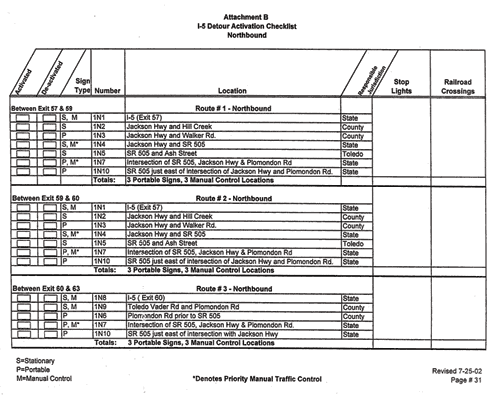 |
| Figure 5-11. Alternate route activation checklist. (Source: Washington State DOT) |
|
| Figure 5-12. Contact matrix for a regional freeway alternate route plan. (Source: New England Region I-95 Corridor Coalition) |
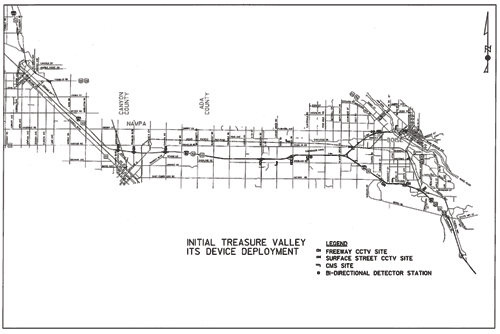 |
| Figure 5-13. ITS equipment location map. (Source: Idaho Transportation Department) |
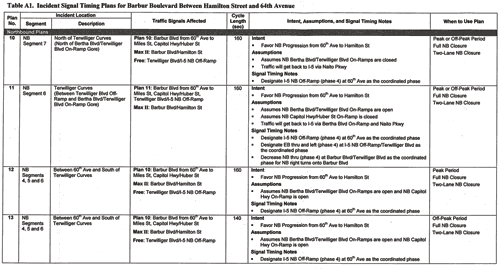 |
| Figure 5-14. Alternate route traffic signal timing plan. (Source: Oregon DOT) |
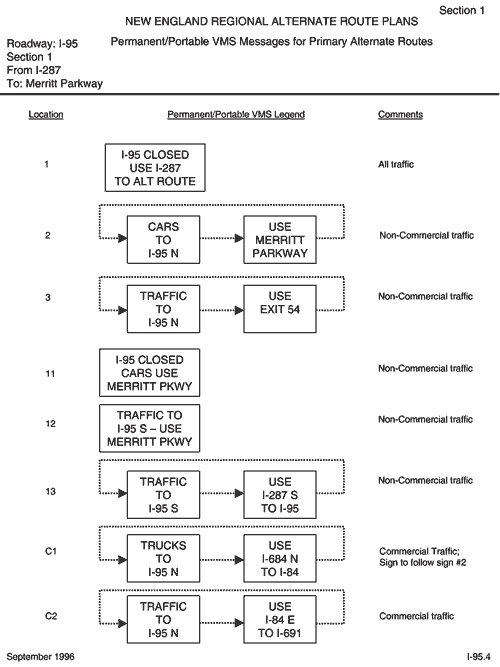 |
| Figure 5-15. CMS message plan. (Source: New England Region I-95 Corridor Coalition) |
| ITS HIGHWAY ADVISORY RADIO MESSAGES |
| 1. Welcome to the S.C. Highway Advisory Radio broadcast. |
| 2. Use alternate routes. |
| 3. Heavy congestion ahead. Expect delays. |
| 4. Adverse weather conditions. Drive carefully. |
| 5. Dial *HP for emergency assistance. |
| 6. Expect no delays. |
| 7. Accident at exit 90 Carowinds Blvd. |
| 8. Accident at exit 88 Gold Hill Road south bound. |
| 9. Accident at exit 85 S.C. 160 south bound. |
| 10. Accident at exit 83 S.C. 49 south bound. |
| 11. Accident at exit 82-A S.C. 161 south bound. |
| 12. Accident at exit 82-B Cherry Road south bound. |
| 13. Accident at exit 79 Dave Lyle Blvd. south bound. |
| 14. Accident at exit 77 U.S. 21 & S.C. 5 south bound. |
| 15. Accident at exit 75 Porter Road south bound. |
| 16. Accident at exit 73 S.C. 901 south bound. |
| 17. Accident at exit 90 Carowinds Blvd. |
| 18. Accident at exit 88 Gold Hill Road north bound. |
| 19. Accident at exit 85 S.C. 160 north bound. |
| 20. Accident at exit 83 S.C. 49 north bound. |
| 21. Accident at exit 82-A S.C. 161 north bound. |
| 22. Accident at exit 82-B Cherry Road north bound. |
| 23. Accident at exit 79 Dave Lyle Blvd. north bound. |
| 24. Accident at exit 77 U.S. 21 & S.C. 5 north bound. |
| 25. Accident at exit 75 Porter Road north bound. |
| 26. Accident at exit 73 S.C. 901 north bound. |
| 27. South bound lane closed for construction. |
| 28. North bound lane closed for construction. |
|
| Figure 5-16. HAR message plan. (Source: South Carolina DOT) |
DEVELOP ALTERNATE ROUTE PLAN IMPLEMENTATION GUIDELINES
After selecting the alternate routes, stakeholders must determine decision criteria to achieve a consensus and determine when to implement an alternate route plan, after an incident has occurred. Some agency incident responders or Incident Commanders may choose to implement the alternate route plan whenever there is at least one lane closed, while others may only implement the alternate route plan when the entire roadway is closed. The choice of when to implement the alternate route plan typically represents a function of traffic capacity lost on the mainline due to roadway closure and the traffic capacity available on the alternate route. Table 5-2 describes the roles of stakeholders involved in the development of alternate route plan implementation guidelines.
Table 5-2. Stakeholder involvement in developing alternate route plan implementation guidelines
| STAKEHOLDER |
ROLE |
| Transportation/public works agency |
- As lead agency, set alternate route plan implementation guidelines.
- Set restrictions as to when their roads may be used as alternate routes.
|
| Law enforcement |
- Provide input as to when the plan should be implemented due to potential resource constraints at certain times.
|
| Fire department |
- Provide input as to when the plan should be implemented.
|
| Turnpike/toll authority |
- Determine when the tolls may be waived.
|
Minimum Actions for Implementing Alternate Route Plans
The task of implementing alternate route plans involves the following minimum action: set guidelines for deciding when to implement an alternate route plan. Consider factors such as number of lanes closed, anticipated incident duration, observed traffic conditions, and the time of day/day of week. Associated considerations include:
- The major factors that most agencies consider include:
- Incident duration
- Number of lanes blocked
- Observed traffic conditions
- Time of day
- Day of week
- The capacity of the proposed alternate route should also be a consideration when making the decision to divert traffic to the alternate route. If the alternate route has a very low capacity (yet represented the only viable alternate route during the selection phase), then it should only be used as an alternate route when absolutely necessary, such as during a long-term complete closure of the mainline (e.g., bridge collapse) or when no other alternative is available.
- The implementation of an alternate route plan requires resources that are usually provided by multiple stakeholders. Stakeholders involved in the alternate route plan implementation should provide input as to how frequently they will be able to implement the alternate route plan given potential resource constraints at certain times.
- The selected criteria must be clearly shown on the plans to ensure that the alternate route plan is implemented only when required. It is best to avoid an overly complex set of criteria. A decision matrix should be created and included in the alternate route plan.
Section 6I of the 2003 Manual on Uniform Traffic Control Devices (MUTCD)1 covers incident management. It presents the following definitions for incident levels:
- Major—expected duration of more than 2 hours.
- Intermediate—expected duration of 30 minutes to 2 hours.
- Minor—expected duration under 30
minutes.
According to the 2003 MUTCD, route diversion is usually needed for major incidents, but rarely used for intermediate or minor incidents. Different agencies, however, may choose to use different guidelines. Some agencies, especially in metropolitan areas, may use route diversion for intermediate incidents, especially if it involves complete closure during rush hour.
Ideal Actions for Implementing Alternate Route Plans
In addition to setting guidelines for deciding when to implement an alternate route plan, consider the following ideal action: set guidelines for partial implementation of an alternate route plan. Depending upon the criteria agreed to by the participating stakeholders, a plan may be partially implemented without the need for all elements. For example, not all traffic control techniques may be needed under certain circumstances. If this is the case, such information should be included in the plan with an explanation of each level of implementation and associated decision criteria for selecting each level. For example, partial implementation may be utilized during a single-lane closure versus complete implementation during a complete closure.
Figures 5-17 and 5-18 show examples of how an alternate route plan may be implemented in various stages. Figure 5-17 shows a response plan developed for an incident of intermediate duration. Figure 5-18 shows a response plan for an incident of extended duration as a result of a full freeway closure in one or both directions.
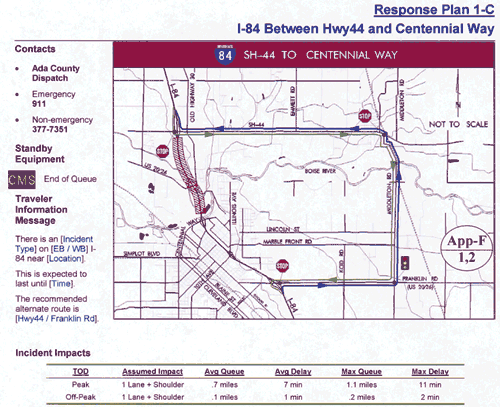 |
| Figure 5-17. Response plan for incident of intermediate duration. (Source: Idaho Transportation Department) |
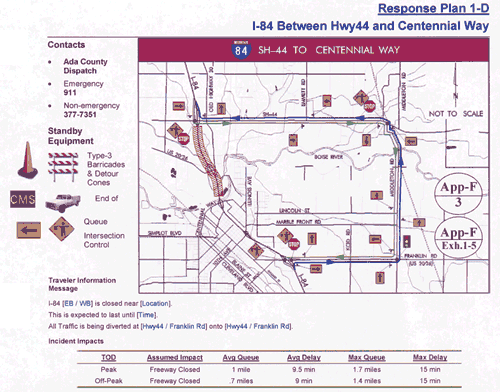 |
| Figure 5-18. Response plan for incident of extended duration.
(Source: Idaho Transportation Department) |
DEVELOP GUIDELINES FOR DISCONTINUING ALTERNATE ROUTE PLAN IMPLEMENTATION
Stakeholders should establish guidelines for discontinuing alternate route implementation to ensure that traffic conditions do not significantly deteriorate on the alternate route. In addition to terminating alternate route plans when the primary route is no longer restricted, stakeholders may also terminate alternate route plans when the alternate route is not performing adequately. If the latter occurs, stakeholders should implement a secondary or tertiary alternate route. Table 5-3 describes the roles of stakeholders involved in this step.
Table 5-3. Stakeholder involvement for developing guidelines for discontinuing alternate route
| STAKEHOLDER |
ROLE |
| Transportation/ public works agency |
- As lead agency, establish guidelines for discontinuing the implementation of alternate route plans.
- Determine restrictions based on traffic conditions and time of day as to when the road may be used as the alternate route.
- Terminate the alternate route plan when these conditions are no longer met.
|
| Law enforcement |
- Provide input as to how long the plan can be implemented based on specific traffic conditions or resource constraints that may arise.
|
| Fire department |
- Provide input on the determination of pertinent decision criteria.
|
| Transit agency |
- Determine when transit vehicles will cease using the alternate route.
|
| Turnpike/toll authority |
- Determine restrictions as to when the tolls may be waived.
- Terminate the alternate route plan when tolls can no longer be waived.
|
Minimum Actions for Discontinuing Alternate Route Plan Implementation
The task of discontinuing alternate route plan implementation involves the following minimum action: determine at least one measurable criterion for deciding when to discontinue an alternate route plan, and base the decision on the available capacity on the mainline from where traffic was diverted and the operation of the alternate route. Associated considerations include:
- The diversion of traffic to the alternate route may be phased out when capacity is again restored on the primary route. For example, if an incident initially created a full closure on a roadway and one or two lanes are subsequently opened to traffic, then the restored capacity may be adequate to accommodate mainline traffic flow. As a result, use of the alternate route could be discontinued.
- The diversion of traffic to the alternate route may be discontinued if traffic conditions on the alternate route deteriorate due to a secondary incident or excessive traffic demand that exceeds the capacity of the alternate route. In both instances, it may be necessary to implement a secondary alternate route to accommodate traffic flow from the primary route.
- Most frequently, it may be best to discontinue the alternate route only after the mainline is completely reopened. Decision criteria for discontinuing an alternate route should be established during planning to facilitate a consensus and consistent decisionmaking during each implementation.
Ideal Actions for Discontinuing Alternate Route Plan Implementation
In addition to determining at least one criterion for discontinuing alternate route operations, consider the following ideal action: determine detailed guidelines and scenario-based criteria for deciding when to discontinue an alternate route plan. Associated considerations include:
- Decision criteria for discontinuing an alternate route should be clearly shown on the alternate route plans, and overly complex criteria should be avoided. In the same ways alternate route plans may be implemented at different levels, they may also be terminated in stages, and this should be noted. For example, an agency may wish to change the implementation level to a lower level when one lane is reopened, and completely terminate the plan when the entire roadway is reopened. For example, if an alternate signal timing plan is used on the alternate route, the signal timing plan may revert to the standard plan if conditions warrant, before the alternate route plan is terminated.
- Stakeholders should set a well-defined set of guidelines for terminating an alternate route plan. The alternate route plan should contain an alternate route operation evaluation plan for assessing whether to discontinue an alternate route and/or implement a secondary alternate route, based on traffic conditions on the alternate route. The primary factor in this decision may be observed travel time on the alternate route. When the travel time on the alternate route exceeds the travel time on the mainline (including remaining time needed for the incident to be cleared), the alternate route should be terminated.
- The plan should state which stakeholders (or Incident Commander) have the authority to make the decision to discontinue use of the alternate route, and under what circumstances, defined by decision criteria, they may make this decision.
References
- Manual on Uniform Traffic Control Devices, 2003 edition, Federal Highway Administration, Washington, DC, 2003 [Online]. [December 31, 2003].





